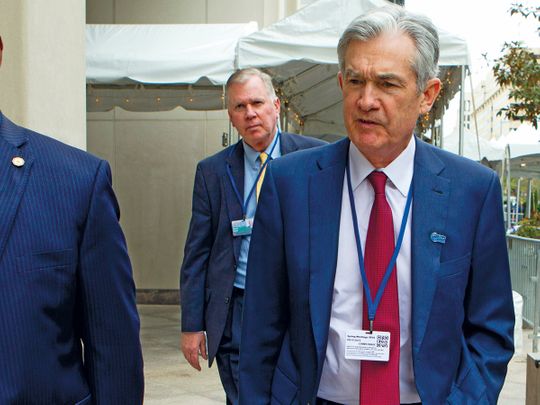
New York: In terms of history, October 3 is a day that will live in stock market infamy. One year ago this week investors were launched into a three-month-long crisis after Federal Reserve Chairman Jerome Powell called interest rates “a long way from neutral.”
And while the world is a different place today, it remains scary. Rate policy has come full-circle, but so have many readings on the economy. Reports this week showed factories in a recession and services suddenly cooling. Investors who came to rely on their one-time antagonist to drive the market higher are now wondering if Powell can do enough to keep everything afloat.
“Every time that we get bad news, it’s like, ‘Let me get a shot of penicillin’,” said Paul Nolte, a portfolio manager at Kingsview Asset Management in Chicago, which oversees $1.4 billion. “The market is very dependent on low interest rates. It’s their drug.”
The precariousness is playing out on traders’ nerves. The S&P 500 just tallied its third straight down week, falling 0.3 per cent over five days. But it ended with a rally that over 30 hours lifted the index more than 3 per cent.
Powell’s rechristening as a dove stands in the centre of the major cases for and against US equities in October 2019. While bulls can take solace in a central bank committed to keeping the economy out of a contraction, unlike last year, no net exists should they fail.
“We did a 180, literally — we were raising rates, we were neutral, then we cut,” Joe Quinlan, head of CIO market strategy for Merrill and Bank of America Private Bank, said by phone. “It’s been a volatile year to say the least since that October 3 speech.”
Volatile, and frustrating — for all its breathless swings the market has barely budged over 365 days, rising less than 1 per cent. It’s a testament to the directionless data over the period, with investors unable to tell how seriously to take the latest bout of recession paranoia.
Consumer confidence is high but last month posted its biggest drop in almost a year. Housing data has been unexpectedly strong, while personal spending is flat. The unemployment rate keeps shrinking, but worker pay stays low.
This week, manufacturing data on Tuesday confirmed factories are in contraction. Forty-eight hours later, a data on services — an insight into the state of the consumer — fell to the lowest level in three years.
Thanks to Fed bets, bad news was occasionally good, as weaker data improved odds the Fed will deliver additional interest rate cuts. The S&P 500 posted its biggest intra-day reversal since December 27 on Thursday, according to Bespoke Investment Group.
Traders of fed funds futures slightly reduced the amount of easing they expect from the Fed this year following the jobs report. Still, they’re expecting the central bank to reduce rates a full 25 basis points, with a 52 per cent chance of an additional quarter-point cut after that.
“The Fed is continuing to walk a really tight rope here,” Oksana Aronov, managing director client portfolio manager JPMorgan Investment Management, told Bloomberg TV. “The economy is continuing to, you could call it slow down, or you could call it continue to grow at a slower pace. Does it warrant a return back to extraordinarily accommodative measures? We think not. But the Fed is caught in a tough spot.”
Still, doubts about the central bank’s efficacy are starting to creep in. Monetary policy tends to work with a lag and many investors are growing increasingly apprehensive over how much three or even four rate cuts can do to stem any serious weakening.
It’s a concern for Cantor Fitzgerald’s Peter Cecchini, who says the Fed is running out of ammunition. “The Fed may want to save its bullets,” the firm’s chief market strategist wrote in a note. “It either needs to fire fast and furious early or save its bullets for an even bigger threat.”
Federal Reserve officials are seemingly as divided as those taking their cue from them. New York Fed President John Williams said this week the US economy remains strong while the outlook is more mixed. Powell is countering the slowdown narrative, as well. The US economy is in a good place but faces some risks, he said in a speech Friday, citing the low unemployment rate and inflation running close to the 2 per cent target.
The through-line in all this has been the on-again, off-again US-China trade relationship, which remains complicated. This week, it took a back seat as worries over the economy overpowered developments elsewhere.
But it’s at the forefront of investor’s minds again, with October 10 and 11 circled on calendars across Wall Street. Chinese officials are set to visit the US next week for further trade talks, though the president threatened that “if they don’t do what we want, we have tremendous power.”
To Federated Investors’s Phil Orlando, a trade resolution is the key missing component. “We need to fix China, and then this begins to go away,” the firm’s chief equity strategist said by phone. “There’s only so much the Fed can do. I don’t think that the Fed, even if they continue to work rates down to zero, would have ability to forestall a recession if the China US trade and tariff situation continues to get worse through the balance of this year into next.”












